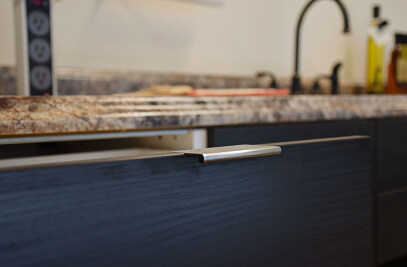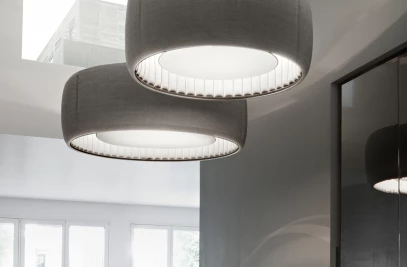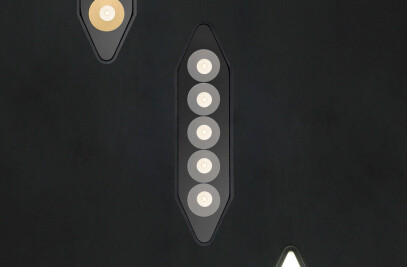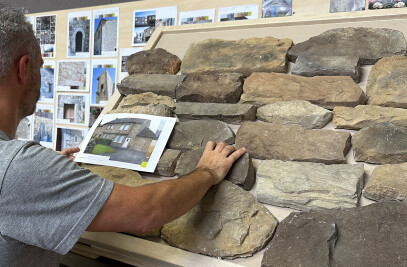Hub of Huts is a real-life Alice-in-Wonderland construction that is mysterious and mischievous, enchanting and entrancing. Described as “the village upside down,” it is a project by architectural firm NOA. Located in Olang, a municipality in South Tyrol in northern Italy, Hub of Huts is a dedicated well-being center that belongs to the Hotel Hubertus.
The interplay of perspectives
NOA first designed the hotel’s impressive cantilevered swimming pool in 2016, envisioned by the studio as “a rock stranded between earth and sky.” Asked by the hotel’s owners to create a new well-being extension, the pool served as inspiration for the project. When observing how the surrounding landscape was reflected in the cantilevered pool, NOA's design concept for Hub of Huts came to life by playing with the horizon line and the idea of upside down.
In an interview with NOA co-founder and architect Lukas Rungger, he explains: “The client's request was to create something out of the ordinary, something that would 'surprise' him, as had already been the case with the cantilevered swimming pool. In the project’s brainstorming phase, we thought about possible activities in the wellness areas, such as standing, sitting, swimming, floating horizontally, and diving upside down. Each of these positions has a different horizon — it was from this interplay of perspectives that the idea of the project quickly came to life, in the overturning of horizons.”
A creative experiment
As a creative experiment, Hub of Huts is a unique design that very much transcends style. “In our manifesto, we say that NOA is a laboratory of experimentation, where we look for surprising interpretations of the territory. Hub of Huts is a perfect example of this approach,” says Rungger.
“What in the world did NOA create this time?” is a phrase the studio likes to hear. “We created a small piece of architecture able to cause great astonishment in the observer,” says Rungger. “We have achieved this by flipping the horizon, i.e. by placing the double-pitched huts upside down. In concrete terms, it is a suspended platform that houses various functions for well-being, such as saunas and pools. From the outside, the building conveys the idea of extreme dynamism, while on the inside, there is a form of extreme calm.”
When first seeing the structure, it is conceivable that a person might glance at it, then do a double-take. There is an inherent element of surprise or wonderment in the construction. “This is important,” says Rungger. “We don't want to do crazy things, but we want to use architecture as a tool to change perspectives, to amaze, and to create surprising landscapes.”
Architecture as a unicum
The Hotel Hubertus is located in Olang, at the foot of Kronplatz mountain in the Dolomites. At an altitude of around 1,350 meters, it is positioned to take advantage of the alpine views, something NOA was keen to make the most of in its design for Hub of Huts. “Hubertus is a hotel that has grown over time and has been enriched by interventions from different architectural firms,” says Rungger. “We wanted to establish continuity with our previous project for the hotel, the cantilevered swimming pool. Therefore, we created an architecture that, in the same way as the pool, is a separate element that detaches itself from the main body, a unicum that hovers in the air. This results in an advantageous relationship with the landscape: the view can rotate 360°, making the platform a privileged stage from which to observe the fascinating changes of the surrounding nature.
Construction of Hub of Huts
In its final realization, Hub of Huts appears to defy gravity. Rungger explains: “The lightness of the platform conceals a static system that put the talented team of engineers at iPM to the test. The platform has an overhang of 11 meters and is supported by two circular steel pillars of 60 centimeters in diameter and 14 meters in height.” Outwardly, the platform appears to rest on two massive tree trunks — the steel pillars are cleverly disguised and clad in larch wood.
Rungger continues: “A series of HEB beams that extend perpendicular to the main beams form the deck, which is rhomboid in shape. All of the steelwork structures are hot-dip galvanized [immersed in a bath of molten zinc]. The most difficult part of the project was not so much putting the platform in place, but rather calculating the deformations to ensure the pool water flowed evenly on all four sides.” With its 20 meter overhang, the floating platform is a marvel of structural engineering.
In designing Hub of Huts, it was important to strike a balance between the aesthetic and functional nature of the material choices. “For such an exposed location, the main criteria in the choice of materials was weather resistance,” says Rungger. “The aluminum that was used for both the panels and the brise-soleil [sun shade] system, and the tiles used for the floors, have excellent durability. Furthermore, in both cases, the color palette of the finishes is almost infinite, allowing us to choose a natural brown tone that was in harmony with the surrounding landscape.”
On the facades of the saunas, the cladding changes to slats that act to screen the interior from view, yet allow visitors to look out. The use of pitched roofs was motivated by both functional and practical reasons: “On the one hand, the desire to reproduce the architecture of a mountain village. On the other hand, the practical need to allocate the water purification system of the swimming pool and the seating tiers of the sauna within the inverted roofs.”
When thinking about the structure’s facade, it was important to consider its long-term durability. With aluminum, the metal’s ability to resist weathering, corrosion, rot, and decay is a valued attribute and was one reason why it was chosen as cladding for the facade. Rungger adds: “We also chose to use aluminum because it offered the possibility to easily create a complex mesh, composed of individual triangles, that could cover the thickness of the steel load-bearing beam.”
In a project such as this one, a considered combination of craftsmanship and technology is important. “To realize the project, we needed extremely specialized companies of the highest level. There were over twenty companies on-site, all from the area. We are lucky to operate in a region where the quality of those working in the construction industry is very high. Otherwise, I don’t think this project would have been possible,” says Rungger.
Day-to-day well-being
Visitors to Hub of Huts reach the well-being area (platform) via a suspended walkway — this also opens up to a relaxation area. Once on the platform, they find individual microstructures with gabled roofs — the huts. The upper floor houses two whirlpool baths, two panoramic showers, and a changing room. It is the platform’s lower aspect that is most intriguing, where the huts appear anchored upside down. From a central enclosed foyer, visitors can access a soft sauna, Finnish sauna, shower cabin, ice mist shower, and a third outdoor pool. Descending to the lower level, the temperature rises and the environment is more protected. It is for this reason that Hub of Huts is dubbed the “Heaven and Hell Sky Spa” by the hotel.
In the day-to-day operation of Hub of Huts, the facility seeks to harness renewable energy sources. “The hotel is making a transition to a self-sufficient energy generation model’: explains Rungger. “The energy needed for the wellness platform is produced by the hotel's own wood chip plant, which uses damaged wood from the immediate surroundings, chopped by the farmers in Olang. The capacity of the power plant is 1,400 kW."
Out of the ordinary
In its construction, Hub of Huts offers two very different perspectives when viewed externally and internally. “Perhaps the first word that comes to mind when observing the structure from the outside is surreal,” says Rungger. “And this is exactly what we were seeking to achieve: a different, unexpected interpretation of the space that surrounds us, where the landscape is the protagonist. However, once inside the structure, the inversion of the poles is not at all perceptible. Rather, the sensation is one of extreme calm. The decision to work with single-story elements helped to establish an intimate relationship with the human scale.”
In its architectural practice, NOA sets out to offer a narrative, telling a story around each of the buildings it designs. Rungger observes: “Hub of Huts is a relatively small project based on elementary forms — the double-pitched houses are reminiscent of a mountain village. But in this project, we wanted to keep the creative drive and poetics that are also behind our Hubertus pool design, by creating something unexpected. There are aspects of a theater in this project that result in an ‘out of the ordinary’ spatial perception of purity.”
Hub of Huts credits:
Architecture and interior design: NOA
Structural engineer: iPM Engineering
Client: Gasser Family
Surface area: 460 square meters
Facade: Prennwerk(metal panels), Sparer (metal slats)
Stairs: Sparer
Windows: Tip Top Fenster
Flooring: Appenbichler
Tiling: Gartner Fliesen
Pool: Pikon
Sauna: Arboris















































































